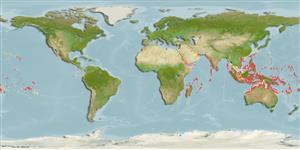Environment: milieu / climate zone / depth range / distribution range
بوم شناسي
دريايي وابسته به آب سنگ; تغييرات عمق 1 - 30 m (Ref. 1602). Tropical; 30°N - 28°S
Eastern Indian Ocean: although reported to occur widely in the Indo-Pacific, specimens have only been collected at the Batu Islands, off Sumatra, Indonesia. Western Indian Ocean: Gravid females have been collected from Seychelles Islands (Ref. 45699).
Length at first maturity / Size / Weight / سن
Maturity: Lm 4.8, range 5 - 5 cm
Max length : 12.0 cm SL جنس نر / بدون خواص جنسي; (Ref. 1602)
خارهاي باله پشتي (کل) : 0; شعاع نرم باله پشتي (کل) : 75 - 88; خارهاي باله مخرجي: 0; شعاع نرم باله مخرجي: 59 - 69; مهره ها: 41 - 45.
Rare species (Ref. 34024) notable for its strict association with true reef environments and particularly so with outer reefs and reef cores (Ref. 81230). An indweller of deep interstices of lagoon and seaward reefs to a depth of at least 30 m (Ref. 1602). Ovoviviparous (Ref. 240). Solitary inhabitant of shallow water, cryptic (Ref 90102).
Ovoviviparous. Sexes can be readily distinguished by the male's intromittent organ and the female's genital pore (Ref. 240, 205). On the basis of this morphology, copulation may involve flexion of the male's body and pumping of sperm into the female (Ref. 240). Embryos are retained in the ovaries until about 6 mm long, deriving nourishment from large yolk sacs, making the species ovoviviparous rather than viviparous (Ref. 240).
Nielsen, J.G., D.M. Cohen, D.F. Markle and C.R. Robins, 1999. Ophidiiform fishes of the world (Order Ophidiiformes). An annotated and illustrated catalogue of pearlfishes, cusk-eels, brotulas and other ophidiiform fishes known to date. FAO Fish. Synop. 125(18):178p. Rome: FAO. (Ref. 34024)
وضعيت در فهرست قرمز IUCN (Ref. 130435)
خطر برای انسان ها
Harmless
استفاده انسانی
ابزارها
گزارش های ويژه
بارگيری XML
منابع اينترنتي
Estimates based on models
Preferred temperature (Ref.
123201): 25.5 - 29.3, mean 28.4 °C (based on 3018 cells).
Phylogenetic diversity index (Ref.
82804): PD
50 = 0.7500 [Uniqueness, from 0.5 = low to 2.0 = high].
Bayesian length-weight: a=0.00389 (0.00180 - 0.00842), b=3.12 (2.94 - 3.30), in cm total length, based on all LWR estimates for this body shape (Ref.
93245).
Trophic level (Ref.
69278): 2.6 ±0.1 se; based on diet studies.
Fishing Vulnerability (Ref.
59153): Low vulnerability (10 of 100).
Nutrients (Ref.
124155): Calcium = 138 [75, 245] mg/100g; Iron = 0.922 [0.534, 1.561] mg/100g; Protein = 16.9 [14.3, 19.3] %; Omega3 = 0.11 [0.06, 0.19] g/100g; Selenium = 32.5 [16.6, 73.1] μg/100g; VitaminA = 88.1 [26.6, 286.7] μg/100g; Zinc = 2.24 [1.53, 3.13] mg/100g (wet weight);
